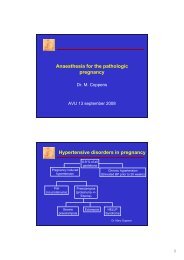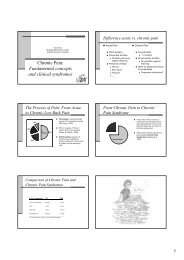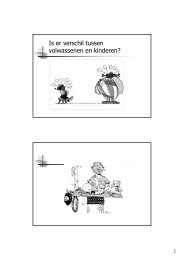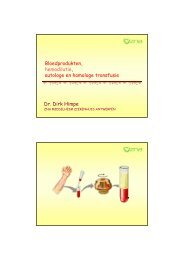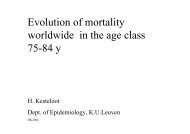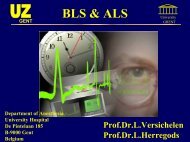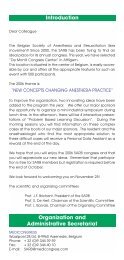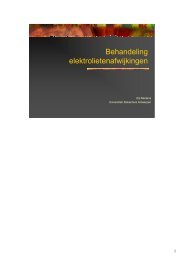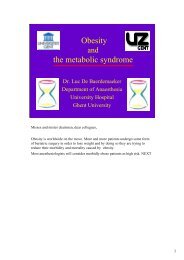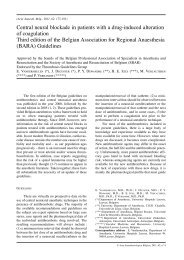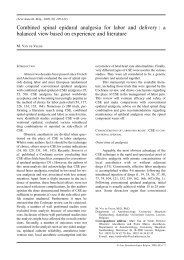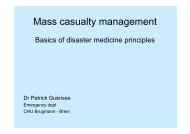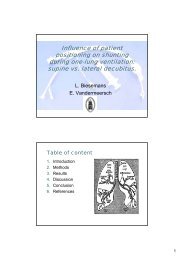Farmacologie van de inhalatie-anesthetica
Farmacologie van de inhalatie-anesthetica
Farmacologie van de inhalatie-anesthetica
Create successful ePaper yourself
Turn your PDF publications into a flip-book with our unique Google optimized e-Paper software.
Volatiele <strong>anesthetica</strong><br />
Farmacodynamica<br />
E. Van<strong>de</strong>rmeersch<br />
History:<br />
• Ether: Valerius Cordis 1540<br />
Crawford Long 1842<br />
• Nitrous oxi<strong>de</strong>: Priestley 1776<br />
Humphrey Davy 1799<br />
• CO 2<br />
• Chloroform: Liebig 1831<br />
Simpson 1847<br />
• Ethyl chlori<strong>de</strong>: 1900<br />
• 1930 - 1940: Ethylene, Cyclopropane, Trichloroethylene,<br />
Isopropenyl vinyl ether
History:<br />
• 1951: Halothane: Suckling<br />
• 1960’s: Methoxyflurane<br />
• 1970’s: Enflurane<br />
Isoflurane ( isomer of enflurane)<br />
Sevoflurane<br />
Desflurane<br />
• Xenon: first used in 1951 by Cullen<br />
Mechanism of action 1:<br />
of excitatory and enhancement of inhibitory transmission<br />
Lipid solubility membrane changes ???<br />
( historical )
Mechanism of action 2:<br />
• GABA A receptor – chlori<strong>de</strong> channel : inhibitory<br />
• Voltage – sensitive calcium channels:<br />
• T – type calcium channel<br />
• L – type<br />
• N – type<br />
• Specific mechanism for Isoflurane<br />
• NMDA receptor : Ketamine is inhibitor<br />
• Nicotinic i acetylcholine li receptors<br />
• Voltage – gated sodium channels<br />
The notion MAC: <strong>de</strong>finitions:<br />
• Mac awake : allows a voluntary response to commands in 50% of patients ( ~ amnestic dose: e.g.<br />
0,7 MAC Halothane)<br />
• MAC 95 : prevents 95% of patients responding to <strong>de</strong>fined noxious stimulus ( original standard MAC<br />
stimulus = skin incision in humans) = 1,3 MAC Halothane (other stimulus = other MAC value for<br />
that particular stimulus e.g.: intubation-MAC)<br />
• MAC BAR : blocks adrenergic response in 50% of patients = 1,5 MAC Halothane<br />
• MAC BAR95 : blocks 95% of patients = 2 MAC Halothane
Minimum Alveolar Concentration:<br />
MAC<br />
• relatieve potentie <strong>van</strong> volatiele <strong>anesthetica</strong><br />
• alveolaire concentratie <strong>van</strong> het anestheticum (in % <strong>van</strong> atm. P) dat<br />
voorkomt dat 50% <strong>van</strong> <strong>de</strong> subjecten beweegt in respons op een standaard<br />
chirurgische incisie<br />
• MAC = AD50 = ED50 (median effective dose)<br />
• 15 1.5 - 2.5 MAC is nodig om anesthesie te on<strong>de</strong>rhou<strong>de</strong>n d met volatiel<br />
l<br />
anestheticum alleen<br />
• MAC awake speelt een rol in ontwaaktij<strong>de</strong>n: een lage MAC waar<strong>de</strong> en hoge<br />
MAC awake is gunstiger (weinig invloed <strong>van</strong> opiaten)<br />
The notion MAC
The notion MAC<br />
Additiviteit <strong>van</strong> MAC<br />
• MAC <strong>van</strong> gassen/dampen is additief : ie<strong>de</strong>r percent N2O<br />
verlaagt <strong>de</strong> MAC waar<strong>de</strong> <strong>van</strong> het dampanestheticum met 1<br />
%<br />
• hypnotica/sedativa: daling MAC tot 100%<br />
• opiaten: additief tot 80% daling MAC (ceiling)
Factoren die <strong>de</strong> MAC beïnvloe<strong>de</strong>n<br />
• leeftijd:<br />
• prematuur (- 20%)<br />
• a terme (+ 20%)<br />
• 1 jaar (+ 40%)<br />
• kind, volwassene (progressieve afname)<br />
• 80 jaar (- 40%)<br />
• interindividueel: 10 - 20% verschil<br />
• temperatuur: - 5% per °C<br />
Factors die MAC beïnvloe<strong>de</strong>n<br />
• zwangerschap: tot 40% lager<br />
• obesitas, hematocriet, geslacht, ASA class.: weinig effect<br />
• hypotensie, hypoxie, hypercarbie: daling<br />
• geen tolerantie ti over tijd: MAC veran<strong>de</strong>rt niet tij<strong>de</strong>ns narcose<br />
• species: grote verschillen
MAC<br />
N2O Halo Enfl Isofl Desfl Sevo<br />
MAC100% O2 105 0.75 1.58 1.28 6 1.7<br />
MAC70% N2O 0.29 0.57 0.56 3 0.66<br />
AD95 0.9 1.88 1.68 6-8 2.07<br />
MACawake<br />
multiple x<br />
MAC<br />
MACpart P<br />
mmHg<br />
0.6-0.8 71 0,41 0.52 0.51 0.29 0,43 2.5 0.63<br />
800 5.7 12 9.7 45.6 13<br />
MAC loss of consciousness & recall = 0,4 – 0,5 MAC MAC awake = 0,15 – 0,5 MAC: this means some form of hysteresis
Chemistry:
F Br<br />
F Cl F<br />
F C C H H C O C C F<br />
F<br />
Cl<br />
Halothane<br />
F<br />
H<br />
Isoflurane<br />
F F Cl F F<br />
F<br />
F<br />
H C O C C H H C O C C F<br />
F<br />
N N O<br />
Enflurane<br />
F F<br />
F<br />
F C<br />
F F<br />
F C<br />
F<br />
H<br />
C<br />
F<br />
O<br />
H<br />
Desflurane<br />
F<br />
C H<br />
H<br />
F<br />
Sevoflurane<br />
Fysische kenmerken<br />
MG Kookpunt Dampdruk<br />
N 2<br />
O 44 - 88 39 000<br />
Halothane 197 50.2 243<br />
Enflurane 184 56.5 175<br />
Isoflurane 184 48.5 238<br />
Desflurane 168 23.5 664<br />
Sevoflurane 201 58.5 160
Partitiecoëfficiënten (37°)<br />
bloed/<br />
hersenen<br />
lever/<br />
spier/<br />
vet/<br />
olie/<br />
gas /bloed bloed bloed bloed gas<br />
N 2<br />
O 0.47 1.1 0.8 1.2 2.3 1.4<br />
Halothane 2.54 1.9 2.1 3.4 51 224<br />
Enflurane 1.91 1.4 2.1 1.7 36 98.5<br />
Isoflurane 1.46 1.6 1.8 2.9 45 90.8<br />
Desflurane 0.42 1.29 1.31 2.02 27.2 18.7<br />
Sevoflurane 0.69 1.7 1.85 3.13 47.5 53.4<br />
Nitrous oxi<strong>de</strong>: second gas effect &<br />
diffussiehypoxie<br />
• Second gas effect – concentrating effect – concentration<br />
effect<br />
• vrijkomen <strong>van</strong> grote volumes lachgas uit <strong>de</strong> weefsels naar <strong>de</strong><br />
alveolen bij stoppen toediening verdunt <strong>de</strong> concentratie <strong>van</strong><br />
aanwezige O 2 en CO 2
Nitrous oxi<strong>de</strong><br />
• 30 maal meer oplosbaar in bloed dan stikstof: diffusie naar<br />
luchthou<strong>de</strong>n<strong>de</strong> holten met volume-expansie of drukstijging:<br />
gasembolen, pneumo-encephalon, pneumothorax, darmen,<br />
mid<strong>de</strong>noor…<br />
• Volume of pneumothorax will double in 10 min when 70 % N2O<br />
is given<br />
• Stop immediately with N2O administration if air embolism<br />
occurs<br />
• Beware with the use of N2O in cavity surgery<br />
• Nitrous oxi<strong>de</strong> and intra-ocular gas !!!!!<br />
• Nitrous oxi<strong>de</strong> and endoscopic surgery in general : combustion ?<br />
( N2O for establishing e.g. pneumoperitoneum )
Nitrous oxi<strong>de</strong>: circulatoire effecten<br />
• verhoogt <strong>de</strong> sympathische tonus:<br />
• hogere noradrenaline concentraties<br />
• toegenomen perifere weerstand<br />
• lichte daling hart<strong>de</strong>biet<br />
• min<strong>de</strong>r bloeddrukdaling dan met MAC- equivalent <strong>van</strong><br />
volatiele <strong>anesthetica</strong><br />
• renale / splanchnische vasoconstrictie<br />
Nitrous oxi<strong>de</strong>: an<strong>de</strong>re orgaan effecten<br />
• No inhibition of HPV but rather increase in PVR<br />
• cerebraal: verhoging CMR, CBF, ICP<br />
• Zeer beperkte spierrelaxatie
Nitrous oxi<strong>de</strong>:<br />
biotransformatie en toxiciteit<br />
• UV-rays: NO formation: ozonlayer !<br />
• inhibition methionine synthetase: megaloblastic or aplastic anemia (phe)<br />
/ hyperhomocysteinemia ? (= pharmacogenetic question)<br />
• After 36 hour exposition: transient stop white cell formation<br />
• door oxidatie <strong>van</strong> cobalt in vit B12: Δ synthese tetrahydrofolate (DNA<br />
substraat): neurologic <strong>de</strong>ficits (prolonged heavy exposure = phe)<br />
(<strong>de</strong>ntists) reversable<br />
• phe: reduced fertility, more spontaneous abortion<br />
• Weak trigger of MH<br />
• No carcinogenicity or mutagenicity / teratogenicity not proven<br />
• May induce <strong>de</strong>pen<strong>de</strong>ncy<br />
Volatiele <strong>anesthetica</strong> voor inductie<br />
• halothane: geschikt doch cave hemodynamische effecten<br />
• sevoflurane: geschikt, single-breath inductie, min<strong>de</strong>r<br />
hemodynamische effecten, cave excitatie<br />
• isoflurane: mogelijk doch onaangenaam en niet ongevaarlijk<br />
• enflurane: niet populair<br />
• <strong>de</strong>sflurane: gecontraindiceerd, luchtwegirritatie,<br />
larynxspasme
Stages of inhalation anesthesia<br />
Halothane: hemodynamica<br />
• myocard<strong>de</strong>pressie met daling <strong>van</strong> het hart<strong>de</strong>biet<br />
• gering effect op perifeer vasculaire weerstand (SVR)<br />
• geen orthosympatische activatie; bij neonaten <strong>de</strong>pressie en<br />
parasympathisch overwicht<br />
• weinig Δ polsfrequentie, baroreceptor reflex on hypovolemia impaired<br />
• geen coronaire vasodilatatie<br />
• coronaire bloedflow daalt
Isoflurane: hemodynamica<br />
• matige myocard<strong>de</strong>pressie (
Enflurane: hemodynamica<br />
• daling myocardcontractiliteit (>halo)<br />
• daling SVR (halothane
Sevoflurane: hemodynamica<br />
• vermin<strong>de</strong>ring contractiliteit als isoflurane<br />
• daling SVR min<strong>de</strong>r groot dan isoflurane<br />
• polsfrequentie veran<strong>de</strong>rt weinig<br />
• geen adrenerge stimulatie bij snelle concentratiestijging, geen<br />
sensitisatie voor catecholamines<br />
• vermin<strong>de</strong>ring myocard VO2, coronair dilatatie, geen steal<br />
Circulatoire effecten<br />
BP<br />
halo enfl isofl <strong>de</strong>sfl sevo<br />
HR<br />
NC<br />
NC<br />
NC<br />
SVR<br />
NC<br />
CO<br />
NC<br />
NC
SVR (dyn.s.cm -5 )<br />
200<br />
0<br />
-200<br />
-400<br />
-600<br />
-800<br />
halothane<br />
isoflurane<br />
<strong>de</strong>sflurane<br />
sevoflurane<br />
0.5 1 1.5 2 2.5 MAC<br />
Eger EI II Anesthesiology 55:559,1981<br />
CI (L/min/m 2 )<br />
0.5<br />
0<br />
halothane<br />
isoflurane<br />
<strong>de</strong>sflurane<br />
sevoflurane<br />
-0.5<br />
-1<br />
-1.5<br />
0.5 1 1.5 2 2.5 MAC<br />
Weiskopf Eger EI RB II et Anesthesiology al. Analg 75:517,1991 55:559,1981
HR (bts/min)<br />
30<br />
20<br />
halothane<br />
isoflurane<br />
<strong>de</strong>sflurane<br />
sevoflurane<br />
10<br />
0<br />
0.5 1 1.5 2 2.5 MAC<br />
Weiskopf Eger EI RB II et Anesthesiology al. Analg 75:517,1991 55:559,1981<br />
Prikkelgeleiding<br />
• halothane vermin<strong>de</strong>rt sino-atriale geleiding: atrioventriculair<br />
ritme<br />
• halothane sensitiseert myoard voor catecholamines:<br />
ritmestoornissen (VES)<br />
• enflurane: negatief lusotroop (diastolic function = ability to<br />
relax), junctioneel ritme frequent (daling HD)
Orgaanperfusie<br />
• huid en spieren: toename perfusie<br />
• intestinum: daling <strong>van</strong> darm- en leverperfusie (vooral vena<br />
porta)<br />
• additie <strong>van</strong> N 2 O versterkt dit effect<br />
• zuurstofvoorziening beter bewaard met iso-, <strong>de</strong>s- en<br />
sevoflurane door vasodilatatie arteria hepatica<br />
• nieren: perfusie afhankelijk <strong>van</strong> totaal haemodynamisch<br />
effect<br />
Cerebrale effecten<br />
• cerebrale vasodilatatie, daling CMR<br />
• CO 2 -gevoeligheid blijft bewaard bij normale patiënt (ook in<br />
alle pathologische omstandighe<strong>de</strong>n ??)<br />
• autoregulatie-mechanisme wordt verstoord bij hogere<br />
concentraties: CBF wordt druk-afhankelijk
Cerebrale effecten<br />
• enflurane is epileptogeen bij hoge concentraties (2 MAC)<br />
vooral indien ook hyperventilatie<br />
• aan normale concentraties verhoogt enflurane <strong>de</strong> frequentie<br />
<strong>van</strong> aanvallen niet bij epilepsiepatiënten<br />
• sevoflurane: pro-convulsieve eigenschappen ?<br />
Volatiele <strong>anesthetica</strong>:<br />
respiratoire effecten<br />
• ventilatie-controle<br />
• bronchomotor tonus<br />
• pulmonaire vasculaire weerstand<br />
• mucociliaire functie
Ventilatie-controle<br />
• VT neemt af en AF neemt toe: oppervlakkig a<strong>de</strong>men:<br />
atelectasen, (verhoog<strong>de</strong> a<strong>de</strong>mhalingsarbeid)(inductie<br />
vertraagt)<br />
• MV neemt af en pCO2 neemt toe (meer uitgesproken bij<br />
COLD: mechanisch h ventileren)<br />
• enflurane en <strong>de</strong>sflurane meer invloed dan halothane en<br />
sevoflurane<br />
• Apnea periods in ex-preterm up to 50 weeks post-conceptual<br />
Ventilatie-controle<br />
• CO 2 gevoeligehied neemt af: verhoog<strong>de</strong> rust PaCO 2<br />
(halothane < isoflurane, sevoflurane < enflurane,<br />
<strong>de</strong>sflurane, N 2 O geen invloed )<br />
• aan 1 MAC is hypoxische respons afwezig, doch ook aan 0.1<br />
MAC reeds gestoord (initiele postoperatieve perio<strong>de</strong>, Paza!)
PaCO2 (mmHg)<br />
90<br />
80<br />
70<br />
60<br />
50<br />
40<br />
<strong>de</strong>sflurane + O2<br />
isoflurane<br />
<strong>de</strong>sflurane + N2O<br />
halothane<br />
N2O<br />
30<br />
0 0.5 1 1.5 2 MAC<br />
Eger EI II Desflurane Compendium, 1993<br />
100<br />
% of awake CO2-response slope<br />
50 enflurane halothane<br />
0<br />
isoflurane<br />
0 1 2 MAC<br />
Eger EI II Anesthesiology 55:559,1981
20 V (L/min)<br />
15<br />
10<br />
5<br />
25<br />
20<br />
15<br />
10<br />
hypoxic response<br />
awake<br />
halothane 0.1 MAC<br />
awake<br />
5<br />
halothane 1.1 MAC<br />
40 50 60 70 80 90 100<br />
PO2 mmHg<br />
Knill RL, Gelb AW Anesthesiology 49:244,1979<br />
600<br />
<strong>de</strong>sflurane+60% N2O<br />
<strong>de</strong>sflurane<br />
8<br />
300<br />
Vt<br />
ml<br />
4<br />
V<br />
L/min<br />
40<br />
30<br />
20<br />
10<br />
awake 1 2 MAC<br />
RR<br />
(b/min)<br />
85<br />
75<br />
65<br />
55<br />
45<br />
awake 1 2 MAC<br />
PaCO2<br />
mmHg<br />
awake 1 2 MAC<br />
awake 1 2 MAC<br />
male volunteers<br />
Wartlier DC, Pagel PS Anest Analg 75:517,1992
Bronchomotor tonus<br />
• bronchodilatatie <strong>van</strong> acetylcholine geïnduceer<strong>de</strong><br />
bronchoconstrictie<br />
• directe bronchodilatatie<br />
• halothane/sevoflurane > isoflurane/enflurane/<strong>de</strong>sflurane<br />
• (enkel wanneer toegediend d langs luchtweg)<br />
Pulmonaal vasculaire weerstand<br />
• dilatatie <strong>van</strong> pulmonaal vaten<br />
• hypoxische pulmonaire vasoconstrictie wordt <strong>de</strong>ficiënt: shunt<br />
fractie neemt toe<br />
• daardoor neemt het verschil tussen alveolaire en arteriële O 2<br />
spanning toe
Shuntberekening:<br />
in PVR in respons se to hypoxia<br />
% change<br />
30<br />
20<br />
10<br />
0<br />
-20<br />
-40<br />
-60<br />
-80<br />
-100<br />
1 2 3 MAC<br />
halothane<br />
halothane + N20<br />
isolated lobe of the dog<br />
isoflurane<br />
isoflurane + N20<br />
Benumoff JL and Wahrenbrock EA Anesthesiology 46:111, 1977
Mucociliaire functie<br />
• an<strong>de</strong>re factoren moeilijk te isoleren: positieve druk, (cuff ?),<br />
(droge gassen), hogere O 2 concentratie..<br />
• vermin<strong>de</strong>r<strong>de</strong> “beat frequentie” <strong>van</strong> ciliae bij protozoa en in<br />
vitro-celkweken<br />
• <strong>de</strong> rol <strong>van</strong> volatiele <strong>anesthetica</strong> in <strong>de</strong> inci<strong>de</strong>ntie <strong>van</strong><br />
pulmonaire verwikkelingen is niet dui<strong>de</strong>lijk<br />
Neuromusculaire effecten<br />
• een eigen myorelaxerend effect door een postsynaptisch<br />
mechanisme t.h.v. neuromusculaire junctie<br />
• potentiatie <strong>van</strong> <strong>de</strong> effecten <strong>van</strong> myorelaxantia (tot meer dan<br />
50% min<strong>de</strong>r nodig)<br />
• isoflurane, enflurane, <strong>de</strong>sflurane > halothane en sevoflurane
Muscle relaxating effects of inhalation agents:<br />
Uteriene en foetale effecten<br />
• concentratie-afhankelijke ti myometrium - relaxatie: cave<br />
partale bloeding (enkel lage concentraties gebruiken)<br />
• wel placentaire overgang: geen klinische evi<strong>de</strong>ntie <strong>van</strong><br />
problemen<br />
• N 2 O: interfereert met methionine-synthetase (DNA<br />
replicatie): quid belang bij zwangere?
Maligne hyperthermie<br />
Alle volatiele <strong>anesthetica</strong> zijn potentiële<br />
triggers <strong>van</strong> maligne hyperthermie !!!!!<br />
Biotransformatie en toxiciteit<br />
• vooral metabole producten bepalen toxiciteit<br />
• groter metabolisme : meer risico !?<br />
• langere verblijfsduur in het lichaam : meer metabolisme<br />
(oplosbaarheidscoëfficiënt)
Biotransformatie<br />
Mth Methoxyflurane 40 - 50 %<br />
Halothane 15 - 20 %<br />
Sevoflurane 3 %<br />
Enflurane 2 %<br />
Isoflurane 0.2 %<br />
Desflurane 0.02 %<br />
Toxiciteit: halothane<br />
• halothane hepatitis: 1/10 000 volw.; extremely rare in children: type I &<br />
type II<br />
• type I: asymptomatic transient transam. increase 2 w post anest.<br />
requires no treatment<br />
• type II: onset from 7 – 28 d post anest. mortaliteit 50%<br />
• spontaneous <strong>de</strong>composition: Thymol
Toxiciteit: halothane<br />
• reductieve metabolieten: type I<br />
• meer bij leverischemie (halothane reduces liver blood<br />
flow)<br />
• immunologisch mechanisme: type II: acyl hali<strong>de</strong><br />
intermediate breakdown molecule binds to liver cells, this<br />
complex is recognized by immunocompetent cells<br />
Toxiciteit: enflurane<br />
• cytochroom P 450 mediated : difluoromethoxydifluoroacetaat,<br />
inorganic fluori<strong>de</strong><br />
• nefrotoxiciteit (tubuluscel beschadiging met polyure<br />
nierinsufficiëntie) indien F > 50 µM/L ( which is never<br />
reached ) / not to be used in renal insufficiency ?<br />
• MAC-uur: langdurige anesthesies<br />
• Resistant to <strong>de</strong>gradation by absorbent
Toxiciteit: sevoflurane<br />
• cytochroom P 450 2E1: hexafluoroisopropanol en inorganic<br />
fluori<strong>de</strong><br />
• cave enzyme-inductie: metabolisme x 3<br />
• 7% <strong>van</strong> <strong>de</strong> patiënten: F > 50 µM/L<br />
• maar P450 2E1 (CYP2E1) niet in nieren en al bij al korte perio<strong>de</strong><br />
<strong>van</strong> gestegen F spiegel na sevo<br />
• tubulaire toxiciteit twijfelachtig met gevoelige test: N-acetyl-Bglucosamidase<br />
(NAG) in urine<br />
Toxiciteit: sevoflurane<br />
• in contact met droge, warme (>50°C) CO2-absorber:<br />
compound A, B, C, D (olefins) especially with Baralyme and<br />
NaOH and KOH containing absorbent<br />
• compound A: renale tubulusnecrose (in rat but not in human<br />
but β-lyase nee<strong>de</strong>d in both to produce reactive thiadacyl<br />
intermediates)<br />
• toxische concentratie: 110 ppm<br />
• verse gasflow > 1 L noodzakelijk to prevent ?????
Toxiciteit: isoflurane en <strong>de</strong>sflurane<br />
• wegens <strong>de</strong> geringe metabolisatie <strong>de</strong> veiligste producten<br />
• <strong>de</strong>sflurane: keuzeproduct voor langdurige anesthesies<br />
• No <strong>de</strong>gradation by absorbent<br />
• BUT CO production especially by Desflurane in excessively<br />
dry absorbant ( first case of day) ( less with Iso and Enfl):<br />
pulse oxym. may be fooled<br />
Chronische toxiciteit<br />
• mutageen ?: enkel <strong>anesthetica</strong> met dubbele bindingen<br />
(divinyl ether, fluroxene, trichloorethyleen)<br />
• cancerogeen: surveys: zeer twijfelachtig: iets meer kanker<br />
(1.3x) bij vrouwen met chronische expositie<br />
• teratogeen: ?
% increase above control women wives of exposed men<br />
abortion major anomaly abortion major anomaly<br />
Askrog 1970<br />
Cohen 1971<br />
Knill-Jones 1972<br />
65<br />
270<br />
30<br />
negative<br />
-<br />
160<br />
170<br />
-<br />
-<br />
negative<br />
-<br />
-<br />
Rosenberg 1973<br />
Corbett 1974<br />
ASA 1974<br />
Knill-Jones 1975<br />
Cohen 1975<br />
Pharoah 1977<br />
70<br />
-<br />
30<br />
40<br />
-<br />
negative<br />
negative<br />
190<br />
60<br />
negative<br />
-<br />
negative<br />
-<br />
-<br />
negative<br />
negative<br />
80<br />
-<br />
-<br />
-<br />
30<br />
negative<br />
negative<br />
-<br />
Ericson 1979<br />
Cohen 1980<br />
Axelsson 1985<br />
Hemminki 1985<br />
Guirguis 1990<br />
negative<br />
160<br />
negative<br />
negative<br />
98<br />
negative<br />
60<br />
-<br />
negative<br />
124<br />
-<br />
50<br />
-<br />
-<br />
130<br />
-<br />
negative<br />
-<br />
-<br />
46
Xenon :<br />
Xenon :
Xenon :<br />
Allowed for clinical use since 2005 / since 2007 in a few other countries



